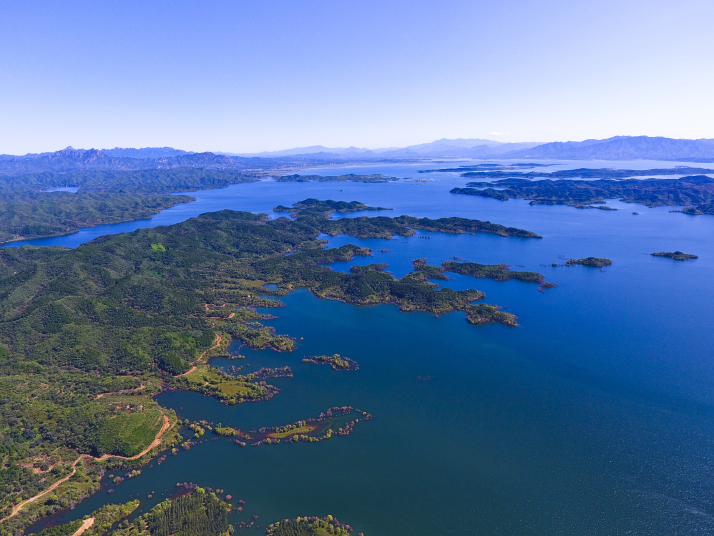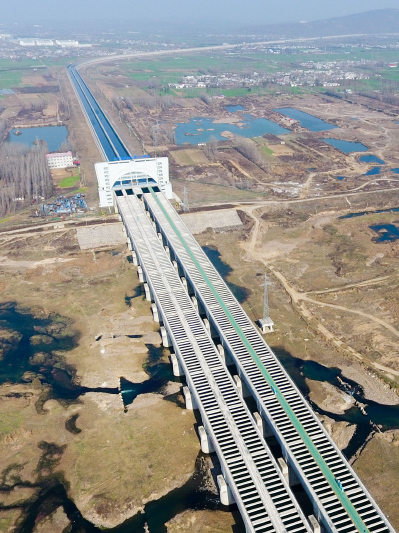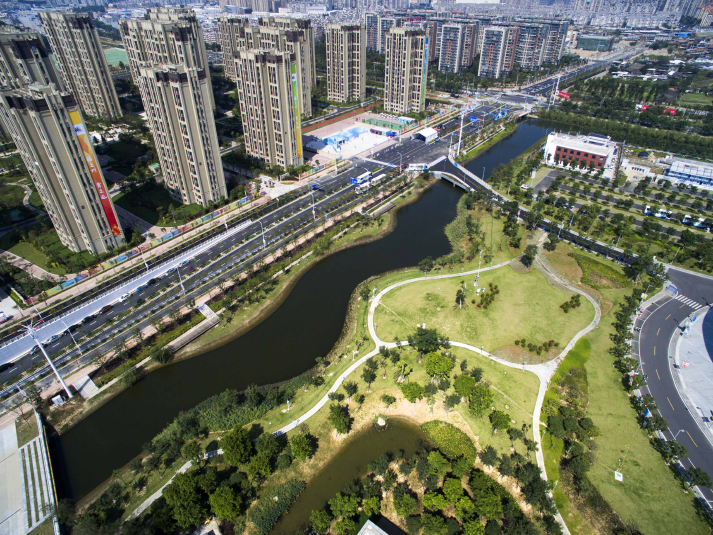|
||||||||||
| Home Nation World Business Opinion Lifestyle ChinAfrica Multimedia Columnists Documents Special Reports |
|
||||||||||
| Home Nation World Business Opinion Lifestyle ChinAfrica Multimedia Columnists Documents Special Reports |
| Current Cover Story |
| Managing a Priceless Resource |
| China addresses its water security challenges with a range of solutions |
| By Li Xiaoyu | VOL.10 March 2018 ·2018-03-01 |

As this year's World Water Day, which was designated by the United Nations in 1993, approaches on March 22, Pan Kemin, Manager of the Miyun Reservoir in suburban Beijing, can finally breathe a sigh of relief. Having suffered through many years of stress brought about by low water reserves, Pan is now confident that the city has overcome a major challenge to its life's blood.
Built in 1960, the Miyun Reservoir is Beijing's main source of surface water and plays a decisive role in ensuring the capital's water supply.
However, since 1999, the reservoir had endured several consecutive years of drought. In November 2014, its water volume was only 880 million cubic meters, much lower than its expected capacity of 4.3 billion cubic meters.
Miyun Reservoir's conundrum mirrors the water scarcity problems that have been hanging over more than 20 million inhabitants of Beijing in recent years. In the Chinese capital, the availability of water per year per person is 100 cubic meters, merely 1/80 of the world's average, and well below the internationally-recognized 1,000-cubic-meter warning threshold. And this problem does not only concern the capital. According to China's Ministry of Water Resources, 400 of the 669 cities in the country are dealing with insufficient water supply.
However, in November 2017, Pan was elated to see the Miyun Reservoir break a 17-year record when its water volume reached 2 billion cubic meters.
"China's water resources are unevenly distributed geographically, with water resources abundant in the south while less in the north," Pan told ChinAfrica. "China's South-North Water Diversion (SNWD) project has greatly improved the water storage of the reservoir."
Water supply works
As Pan mentioned, the geographical distribution of water resources in China is unbalanced. The vast alluvial plain of the Yellow River, Huaihe River and Haihe River in north China is home to 35 percent of the country's population, but contains only 7.2 percent of its water resources. It is nevertheless a strategic region including not only the capital Beijing, but also Tianjin, a major industrial center and seaport.
To solve this imbalance, the SNWD project started construction in the early 2000s. As its name suggests, the SNWD, a network of canals and rivers divided into the east, central and west lines, totaling more than 4,000 km, aims to divert water from south China's Yangtze River to the drought-threatened areas in north China.

According to official statistics published in September 2017, the central line of the project had carried 9.6 billion cubic meters of water since its commissioning in late 2014, benefiting more than 50 million people. Today, the project supplies about 70 percent of Beijing's water resources.
According to Xu Xinyi, Dean of the College of Water Sciences, Beijing Normal University, another important task of the project is to ensure ecological restoration in dry areas in north China. Groundwater resources, for example, are over exploited and their quality has degraded.
For Xu, the commissioning of the project's central line has effectively reduced excessive groundwater over exploitation, and will gradually cover the accumulated ecological deficit in the past years.
His point of view is borne out by facts and figures. According to data from the Beijing Water Authority, since the end of 2014, Beijing's water treatment plants have started to use water from south China, reducing the use of water of Miyun Reservoir by more than 500 million cubic meters. At the same time, underground water resources in the capital began to replenish themselves.
Saving more water
Beijing's per-capita water resources have now increased from 100 to 150 cubic meters, a direct result of the SNWD project. But experts warn that water scarcity is still a major problem for the city.
E Jingping, Head of the SNWD Office under the State Council, said that water conservation still plays a decisive role in the project's success. "If the beneficiary areas fail to bring their excessive water consumption under control, the project will never be able to solve their water problems."
In 2012, the State Council called for the implementation of the most stringent water resources management system, drawing the strictest limit in terms of the volume and efficiency of water use. By 2030, the amount of water needed to produce 10,000 yuan ($1,587) of industrial output is expected to be less than 40 cubic meters, thus reaching the average level of developed countries.

These efforts have shown good results. For instance, in Beijing, the annual water consumption only increased by 0.6 percent between 2010 and 2016. During the same period, its GDP posted an average annual growth of 10.5 percent and its permanent resident population increased by 1.54 million between 2011-16.
Nature for water
In a speech delivered in December 2013 at a meeting on urbanization, Chinese President Xi Jinping said that better adapting to nature would remain paramount to address the urban water crisis. To help the absorption and runoff of rainwater, he proposed the construction of "sponge cities" (see box) with new green spaces, absorbent floor claddings such as permeable concrete and urban wetlands so as to better use the water from the nature.
In fact, the international community is increasingly aware of the role that ecosystem protection and restoration can play in addressing water challenges. The outcome document of the United Nations Conference on Sustainable Development, held in Rio de Janeiro, Brazil, in 2012, said: "We recognize the key role that ecosystems play in maintaining water quantity and quality and support actions within respective national boundaries to protect and sustainably manage these ecosystems."
In China, some of the objectives of "sponge cities" are to resupply urban groundwater with rainwater, to promote water recycling and to protect and restore natural ecosystems. Beijing is one of the first pilot cities in China to recycle rainwater. Since 2016, more than 70 rainwater projects have been put in place in Beijing's urban areas, with a water retention capacity of 500,000 cubic meters.
And China is far from being alone in tackling this issue. Over the last three years, Cape Town in South Africa has received below-normal rainfall, drying up surrounding land and threatening groundwater replenishment. Cape Town City Council announced on January 22 that if the trend continues, by mid-July, its 4 million inhabitants will have to queue to get their daily water ration.
David Olivier, a researcher at the University of the Witwatersrand in Johannesburg, remains optimistic. He believes that Cape Town has the capacity to cope with the current water supply crisis. Cape Town's water consumption is less than 100 liters per person per day, making it one of the most water-efficient areas in the world, he argues. According to him, the city's desalination plants are sufficient to cope with the crisis. "The people of Cape Town should set an example for the world in terms of how to save water," he added.
Sponge Cities
China's State Council issued a guideline in 2015 on building sponge cities, which can enable buildings, streets and wetlands in cities to absorb, store and release rainwater like a sponge. This concept will better serve the country's new type of urban construction.
According to the guideline, cities in China will collect and utilize 70 percent of the rainwater by 2020, and the percentage will increase to 80 percent by 2030. The construction of such cities is to flexibly control the rainwater and address waterlogging in cities, thus achieving a city development mode during which the rainwater can be naturally stored, permeated and purified. China's Central Government released a pilot list of 16 sponge cities in 2015.
The concept of sponge cities utilizes rainfall, much of which is wasted due to poorly constructed drainage systems in the past. Sponge cities will collect rainwater from roofs and drain it into filtration tanks, which can be stored and used for use in dry periods, or to top up lakes around cities. In addition, bio-retention systems are being developed to collect and purify rainwater from green lungs established alongside city streets.
World Water Day
The World Water Day, designated by the United Nations in 1993 at its 47th General Assembly to be observed on March 22 every year, is about focusing attention on the importance of water. This year's theme - Nature for Water - explores how people can use nature to overcome the water challenges of the 21st century. Today, 2.1 billion people live without safe drinking water at home; affecting their health, education and livelihoods. As per this year's theme, nature-based solutions have the potential to solve many of the global water challenges, with much more able to be done with "green" infrastructure. Planting new forests, reconnecting rivers to floodplains, and restoring wetlands will rebalance the water cycle and improve human health and livelihoods. CA
Saving Water Tips
| About Us | Contact Us | Advertise with Us | Subscribe |
| Copyright Beijing Review All rights reserved 京ICP备08005356号-5 京公网安备110102005860号 |